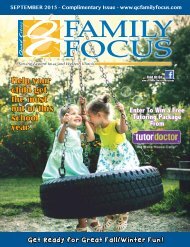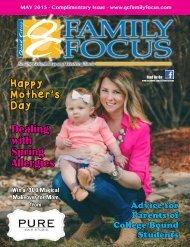QC Family Focus: October 2014
In this issue: A Look at the Very Real Dangers Facing Teens and Tweens Scarecrow Shenanigans Choosing the Perfect Daycare Helping Your Child Prepare for Kindergarten Treats and Snacking can Lead to Tooth Decay Learn more about QC Family Focus Magazine at our website: www.qcfamilyfocus.com Like us on Facebook: www.facebook.com/qcfamilyfocus
In this issue:
A Look at the Very Real Dangers Facing Teens and Tweens
Scarecrow Shenanigans
Choosing the Perfect Daycare
Helping Your Child Prepare for Kindergarten
Treats and Snacking can Lead to Tooth Decay
Learn more about QC Family Focus Magazine at our website: www.qcfamilyfocus.com
Like us on Facebook: www.facebook.com/qcfamilyfocus
Create successful ePaper yourself
Turn your PDF publications into a flip-book with our unique Google optimized e-Paper software.
Staying Strong on the Pitch<br />
ACL Knee Surgery Keeps<br />
<strong>QC</strong> Women Athletes in the Game<br />
Night or day and no matter<br />
what the season, chances are you’ll<br />
find UT soccer player, Gabrielle<br />
Pauwels, 15, Silvis, IL, on the pitch,<br />
playing her favorite sport. “Soccer<br />
keeps me quick on my feet, and I<br />
just love playing defense,” she says.<br />
Her mother, Megan Pauwels, agrees,<br />
“Soccer is Gabrielle’s social life, her<br />
favorite sport, and her first love, so<br />
losing that would have been very hard<br />
for her.”<br />
Gabrielle’s gratitude stems from<br />
her strong comeback following a torn<br />
ACL in her right knee, an increasingly<br />
common injury, especially among<br />
young women athletes who play<br />
pivot sports like basketball, soccer,<br />
or volleyball — sports that demand<br />
jumping, twisting, and sudden stops<br />
that put added pressure on the knee. “I<br />
was just playing kickball and heard a<br />
‘pop,’” recalls Gabrielle. Subsequent<br />
swelling and pain sent her to ORA<br />
Orthopedics’ Sports Medicine Center<br />
for treatment with fellowship-trained<br />
sports medicine physician, Dr. Waqas<br />
Hussain.<br />
ACL reconstruction<br />
“Gabrielle’s telltale ‘pop’ and<br />
swelling indicated a completely torn<br />
ACL,” explains Dr. Hussain (a MRI<br />
confirmed the diagnosis). The ACL<br />
(anterior cruciate ligament) is one of<br />
the four primary ligaments in the knee.<br />
These ligaments control the knee’s<br />
back and forth motion. “The treatment<br />
for a torn ACL is reconstruction,” says<br />
Dr. Hussain. “The first step is reducing<br />
the swelling and preparing the knee for<br />
surgery.”<br />
Dr. Hussain performs ACL<br />
surgery at Crow Valley Surgery<br />
Center, a surgical center specializing<br />
in orthopedics. The surgery is<br />
performed on an outpatient basis and<br />
usually takes about 60-90 minutes<br />
to complete. “To rebuild Gabrielle’s<br />
ACL, I harvested a small part of her<br />
own hamstring tissue and built a new<br />
ligament. This surgery is minimally<br />
invasive and spares surrounding tissue,<br />
UT Panther soccer player, Gabrielle Pauwels, 15, Silvis, is back in the game<br />
after successful ACL reconstructive knee surgery at ORA Orthopedics.<br />
Waqas Hussain, MD<br />
ORA Orthopedics, Davenport<br />
leading to a quicker recovery and<br />
return-to-play,” he explains.<br />
“Patients like Gabrielle are home<br />
the same day and walking soon after.<br />
Strong physical therapy and exercising<br />
usually means athletes can return to<br />
their previous activity between 7-12<br />
months. We also make an effort<br />
to time the surgery with athletic<br />
seasons so that players can be cleared<br />
prior to the opening season.” Every<br />
year ORA performs over 200 ACL<br />
reconstructions.<br />
Women more prone to ACL injury than men<br />
Following surgery and months of rehabilitative<br />
exercise and training, Gabrielle is back playing the<br />
game she loves, but she is not alone in her comeback<br />
to health. According to NIH Medline Plus, young<br />
women are two to eight times more likely than<br />
young males to injure their ACLs. In general, young<br />
female athletes are more prone to ACL injuries<br />
than their male counterparts due to body structure,<br />
hormones, and muscular development.<br />
“Young women experience significant changes in<br />
adolescence. As they develop a wider pelvis, their<br />
knees often point inward to a greater degree. And<br />
because women also have less muscular strength<br />
than men, the result is greater stress being placed<br />
on their ACL. Hormone levels in women can also<br />
mean greater laxity, meaning looser knees that<br />
may also contribute to increased ACL injury,” he<br />
explains.<br />
Dr. Hussain, who completed his sports medicine<br />
fellowship training at the Cleveland Clinic and<br />
served as assistant team physician for such teams<br />
as the Cleveland Browns, Cleveland Indians, and<br />
Cleveland Cavaliers, says prevention is the key to<br />
protecting knees for all young athletes. “Athletes,<br />
especially female athletes, need to learn how to jump<br />
and land correctly. You don’t want knees to buckle<br />
inward. We tell all of our patients that following<br />
surgery, they should work with a physical therapist<br />
so that good habits become second nature. We want<br />
athletes to tear it up on the field as they score that<br />
goal, not tear up their knees and end promising<br />
careers too soon.”<br />
<strong>QC</strong> <strong>Family</strong> <strong>Focus</strong> - <strong>October</strong> <strong>2014</strong> 33<br />
Gabrielle Pauwels (Sports Med).indd 1<br />
9/9/14 12:13 PM

















